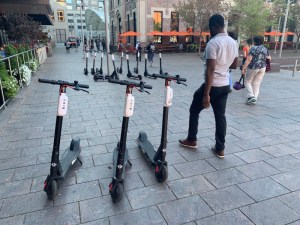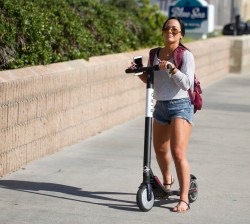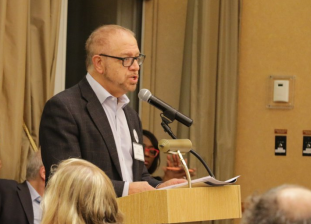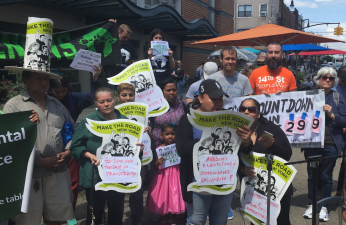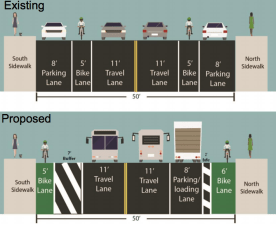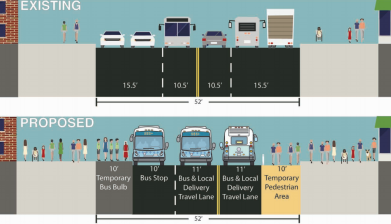Bird Tries to Wedge E-Scooters Into L-Train Shutdown Plans
The company's rosy forecast predicts 5,500 daily e-scooter riders per day during the shutdown.


Then again, the chauffeured mayor has nothing to worry about when the L train shuts down in April — and scooters suddenly become indispensable for stranded commuters.
That’s the message of a report put out Monday by Bird scooters, which is using the looming L-pocalyse to claim that e-scooters will be especially helpful in Brooklyn neighborhoods at Ground Zero of the shutdown [PDF].
The company’s self-serving analysis — it does not mention other e-scooter companies — claims Bird scooters could play a critical role connecting displaced L riders to far-away subways, reducing the time spent getting to and from stations. That, Bird argues, will deter more people from opting for congestion-inducing for-hire vehicles.
Bird’s target users would live in one of three zones located between .5 and 1.5 miles from the J/M/Z trains. The idea is to attract L train riders seeking to access those subway lines, which will be the only trains in the neighborhood providing direct service to Manhattan. (The MTA is also running shuttles buses into Manhattan.)
The proposal anticipates few if any commuters will take the scooters over the bridge. For those that do, scooters would be dropped off and picked up at one of three geo-fenced “nests” in the East Village near 14th Street.
“As part of a broader New York City e-scooter pilot, a deployment of e-scooters has the potential to uniquely serve and benefit commuters most impacted by the L train shut down,” the report by HR&A Advisors says.
But that prediction is hard to support. Most important, it is unclear if there will be buy-in: The company claims 5,500 people will use those scooters each day to either access J/M/Z trains or cross the East River on the Williamsburg Bridge. There’s good reason to doubt that estimate, however. It’s based entirely on a survey that found 21 percent of displaced L riders would be “very likely” to “try” riding an e-scooter to the train or to work.
But the timing of the report is no coincidence: The L train is shutting down this April — and scooters currently play no role in the Department of Transportation/Metropolitan Transportation Authority mitigation plan.
At the same time, pushed by a concerted lobbying effort by companies like Bird and Lime, a cadre of city council members has proposed to legalize e-scooters. One of their bills anticipates Bird’s L train dream by requiring DOT to allow scooter companies to operate in neighborhoods affected by the L shutdown, as well as those currently outside of the Citi Bike service area.
“People are using e-scooters to get from A to B, but as often or more often, they’re using e-scooters to go to that subway stop or train stop or bus stop that’s a little bit out of the way. That’s going to be very relevant to the L train shutdown,” Bird Director of Safety Policy and Advocacy Paul Steely White said at the council members’ press conference unveiling the legislation.
Mayor de Blasio, however, has not been bullish on the latest trend in “micro-mobility,” citing unsubstantiated concerns about safety.

But plans have been in the works for months to increase the number of the Citi Bikes available in areas affected by the shutdown. Citi Bike operator motivate plans to deploy 1,000 pedal-assisted e-bikes for the shutdown, increase the size of its fleet by 1,250 bikes, and provide “valet service” at busy stations to ensure bikes are available.
Ultimately, the report acknowledges that the success of Bird’s proposal depends on what someone is willing to pay to cut his or her walk to the subway. At $1 per ride, plus 15 cents per minute, a typical rider might hop a scooter to cut a 20 minute walk down to five minutes, but many riders in the L-free zone will still be within shorter walking distance to alternative transportation.
And then there’s the issue of L train riders who are already pledged to Citi Bike.
Cost-wise, Citi Bike is a better deal for its regular users: a single Bird ride costs $1 plus $.15-cents per every minute of use. A single Citi Bike ride costs $3, but year-round members pay $169 for unlimited rides. That comes out to just $.23-cents per ride if one rents two Citi Bike per day every day of the year.
“If the e-bikes are available like they say they will be, then I will definitely opt for Citi Bike first, just because I’m already paying for it,” said Max Sholl, a North Brooklyn resident who’s led weekly rides over the bridge ahead of the shutdown.
But Bird’s fleet is 100 percent electric — which could give it a leg-up in attracting riders wary of tiring themselves biking over the Williamsburg Bridge.
“I would definitely be interested in riding one of the Bird e-scooters, especially into Manhattan over the bridge,” Sholl said. “I don’t usually Citi Bike over the bridges because they’re so heavy, and it’s a haul.”
